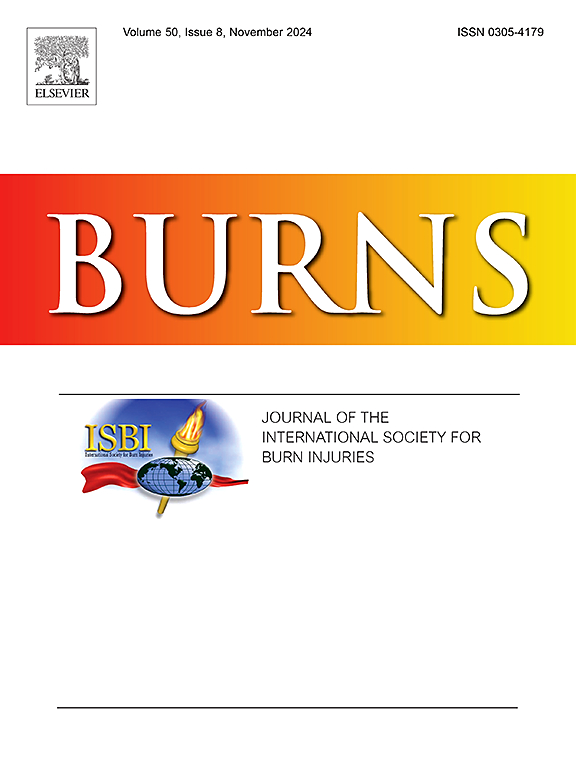激光散斑对比成像预测烧伤创面愈合潜力的有效性:一项关键检查
IF 3.2
3区 医学
Q2 CRITICAL CARE MEDICINE
引用次数: 0
摘要
背景:准确评估烧伤深度对有效治疗烧伤至关重要。虽然临床评估常用,但其准确度仅在50% %和70% %之间。激光多普勒成像(LDI)被认为是金标准-精度超过95% % -用于客观测量愈合电位(HP), HP是LDI设备的输出,在LDI血流图像上以颜色编码。尽管它已被证明有效,但实际挑战阻碍了它的广泛采用。激光散斑对比成像(LSCI)成为一种可能的替代方案。本研究探讨了LSCI与LDI在预测烧伤HP方面的性能和准确性;LDI被认为为惠普的评估提供了“基本事实”。方法住院烧伤患者在烧伤后第2 ~ 5天进行LDI和LSCI扫描。分析包括选择相应的兴趣区域(ROI)在目标伤口优先考虑LDI和LSCI的观点。结果19例患者50个目标创面,在ldi优先范围内收集到112个ROI。从52个目标伤口中收集到lsci优先范围内的130个ROI。阳性预测值(PPV)较低,HP14 - 21和HP21分别仅为50.8% %和68.2% %,HP14为86.9% %。结论不推荐LSCI对烧伤进行客观评估,因为它不能检测皮肤深部血流,导致烧伤严重程度的高估和治疗的潜在不足。本文章由计算机程序翻译,如有差异,请以英文原文为准。
Validity of laser speckle contrast imaging for predicting wound healing potential in burns: A critical examination
Background
Accurate assessment of burn depth is imperative for the efficacious management of burns. Although clinical assessment is commonly used, its accuracy ranges only between 50 % and 70 %. Laser Doppler imaging (LDI) is considered as a gold standard - with an accuracy exceeding 95 %, - for the objective measurement of Healing Potential (HP), HP being the output of the LDI device, as colour-coded on LDI blood flow images. Despite its proven efficacy, widespread adoption is impeded by practical challenges. Laser Speckle Contrast Imaging (LSCI) emerges as a possible alternative. This study investigated the performance and accuracy of LSCI in comparison with LDI for predicting the HP of burns; LDI was assumed to provide ‘ground truth’ for the assessment of HP.
Methods
Hospitalized burn patients underwent LDI and LSCI scans between day 2 and day 5 postburn. Analysis involved selecting corresponding regions of interest (ROI) in target wounds prioritized by LDI and LSCI perspectives.
Results
In 19 patients, 112 ROI within LDI-priority ranges were collected from 50 target wounds. 130 ROI within LSCI-priority ranges were collected from 52 target wounds. Positive predictive values (PPV) were low, at only 50.8 % and 68.2 % for HP14–21 and HP21, respectively, and 86.9 % for HP14.
Conclusion
Objective assessment by LSCI for burns is not recommended, as it fails to detect deep dermal blood flow, leading to an overestimation of burn severity and potential inadequacies in therapy.
求助全文
通过发布文献求助,成功后即可免费获取论文全文。
去求助
来源期刊

Burns
医学-皮肤病学
CiteScore
4.50
自引率
18.50%
发文量
304
审稿时长
72 days
期刊介绍:
Burns aims to foster the exchange of information among all engaged in preventing and treating the effects of burns. The journal focuses on clinical, scientific and social aspects of these injuries and covers the prevention of the injury, the epidemiology of such injuries and all aspects of treatment including development of new techniques and technologies and verification of existing ones. Regular features include clinical and scientific papers, state of the art reviews and descriptions of burn-care in practice.
Topics covered by Burns include: the effects of smoke on man and animals, their tissues and cells; the responses to and treatment of patients and animals with chemical injuries to the skin; the biological and clinical effects of cold injuries; surgical techniques which are, or may be relevant to the treatment of burned patients during the acute or reconstructive phase following injury; well controlled laboratory studies of the effectiveness of anti-microbial agents on infection and new materials on scarring and healing; inflammatory responses to injury, effectiveness of related agents and other compounds used to modify the physiological and cellular responses to the injury; experimental studies of burns and the outcome of burn wound healing; regenerative medicine concerning the skin.
 求助内容:
求助内容: 应助结果提醒方式:
应助结果提醒方式:


